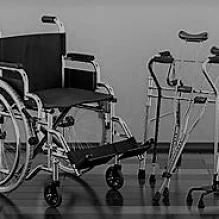
Amputee Motivation, Walker, cane, crutches. Have you ever met anybody that ever said, “hey I like crutches”, think about it, I’ll wait? Who could possibly enjoy the pain in the armpits from having these things hold your body weight up, where, under your arms.
I looked up the word crutch, let me rephrase that, who looks up words anymore, just told my age. I googled the word crutch and Merriam-Webster gave a few definitions for the word crutch. The first two were fitting,
a) a support typically fitting under the armpit for use by the disabled in walking. b) a source or means of support or assistance that is relied on heavily or excessively. Sounds about right. Coming out of the hospital I
quickly went to crutches wanting to get out of the wheelchair so before I had my prosthetic I was on crutches. Needing them to get around the house, needing them for bathroom visits, needing them to make my way to the porch for some sun and to just simply get out of the house.
It’s like crutches became my sidekick. They were becoming quite annoying but very necessary. Then my girlfriend gave me folding crutches for Christmas (who would have ever thought crutches would become my Christmas gift, a gift I was so excited to get.) I could fold these up and get them in and out of the car easy, fold them and put them under the table out of the way when going out to eat etc. But the armpit pain was still very much an issue, bottom line is that crutches are very uncomfortable.
Then once I got my prosthetic, I began to use a walker to learn how to walk with my new leg. A Mobility Walker is a tool for disabled people who need additional support to maintain balance or stability while walking due to physical restrictions. There are different types and makes of walkers on the market, there is also a walker with wheels on it known as a rollator. The difference for the most part is the wheels and it has a seat.
You must lift the walker to move forward, the rollator simply does with the name implies, it rolls. Rollators in my opinion are easier to move around with for example, if you must go shopping or something like that, but walkers are more stable and easier to maneuver in smaller homes and apartments. Walkers are also easier to transport since they tend to be a lot smaller than a rollator and they are also foldable. I did not care too much for all the bending down but the use of a walker for learning to walk on my new prosthetic made sense.
The cane! A walking stick to help redistribute weight from a lower leg that is weak or injured. The cane improves stability by increasing the base of support and improves balance. It was not easy, there was a lot of pain the first few days of being on the cane for sure, but I was ready to walk. I bought a folding cane you could fold up and put in your backpack. Walked on a cane for about a month then began to take a few steps here and there without it, then walking short distances. I still was not ready to walk long distances and was about to start going back to school to learn some new skills and didn’t want to use crutches to get around campus. So, I ordered a knee scooter for situations that requires me to be on my feet to cover long distances and I use my cane still for certain things like snow. Living in Michigan we get plenty of snow and ice and I use my cane on snow days to balance and feel the ground under myself and to help navigate on the ice. I also use my cane when I wear a dress shoe or a boot because of the heel. . Since I wear my gym and casual shoes than shoes with heels, I don’t usually adjust my prosthetic foot to accommodate heels, I just add inserts and grab my cane and I’m out the door. For those wondering and those new to prosthetics, for heels alter the way my prosthetic foot lands and plants on the floor or the ground, basically when I walk. So, the inserts and the cane help me to compensate for the adjustment to the way my prosthetic foot will land or plant when walking in a shoe with a heel. As I said earlier, I purchased a knee Scooter. So, if I’m going downtown or to the grocery store and I know I’ll be out for a while I use my knee scooter. I get stronger everyday and my distance for walking increases daily, but I still use and need my cane from time to time and my knee rover from time to time, should’ve had this thing in the beginning and it looks really cool too!
It made sense in therapy and while I was doing my daily routine of walking down the sidewalk and the driveway still in learning mode, but who wants to tackle a walker to get tacos or burgers. So, as I got use to the prosthetic I went back to the crutches, back to the armpit pain but it was easier for me to improve on my new leg because I could gradually put more weight on my prosthetic as I was able to bear. After building up more tolerance for putting weight on my prosthetic leg I was ready to take it to the next step. . A conversation with a man who had both of his feet burned saying these words to me, “when you are ready to walk, you will”. I was motivated and ready to take the next step.
Be sure to talk with your Dr. and Prosthetist and research each option to determine what mobility aid is right for you, a walker, cane. or crutches given your current health and mobility needs. STAY MOBILE!
Think, I should’ve title this…. Walker, Cane, Crutches, and Knee Scooters!



